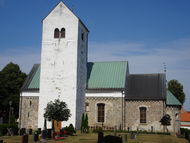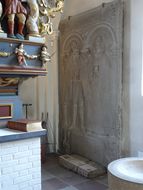
Mior
Excursion map
Skånebilder
Northeast Skåne
Vä kyrka
Photo album
Slideshow
Pictures:
17 August 2020
Pews
Pulpit
Paintings 1
New altar
Paintings 2
Pew
Tombstone 1
Paintings 3
Old altar
Nave from choir
Tombstone 2
Organ
Nave from west
Tombstone 3
Grandmother parents
Church from south
Lapodarium
Cat
Grandfather parents
The cat guides
Cobblestone street
Church from north
17 January 2008
Grandmother parents
Church
Grandmother nephew
Grandfather parents
Read more>>
Naturguiden
Skånetrafiken
 Vä kyrka
Vä kyrkaMarys Church, which was probably taken into use in 1121. In the roof of the choir are paintings from the 12th century. Altar and pulpit from 17th century.
August 17, 2020
It is exactly twelve years since we last visited the graves
of ancestors at Vä Church, St. Mary's Church.
First we make a visit inside the church,
which was probably taken into use in 1121.
Over the years, the church has been rebuilt and rebuilt.
It has had a twin tower in the west that was demolished in 1804.
The current tower in the south is from the 14th century.
On the church pews and a pew in the choir are paintings from the 18th century.
In the roof of the choir are frescoes:
angels, saints, martyrs and Jesus sitting on a rainbow.
The altar in the choir is modern.
The former altar from 1674 stands in the northern part of the church.
Contemporary is the pulpit.
On the north wall hangs a crucifix from the 15th century.
The organ is modern. In the church there are some old tombstones.
We go out to find our "graves".
Grandmother's parents' grave was in the southern part of the cemetery,
west of the aisle. It remains.
There is also my grandmother's oldest sister Hanna,
"aunt" Hanna who is the one I met:
Per Larsson 1853-1930
Anna Larsson 1859-1953
Hanna Andersson 1882-1969
Grandfather's parents' stone lay by the cemetery wall, no grave was left.
Now there are no tombstones there anymore.
Outside the cemetery wall to the south is a lapidarium. Glossary:
"Lapidarium comes from the Latin word for stone lapis and
is a collection of stone monuments, in this case tombstones.
The intention is to preserve stones from older, closed graves.
Tombstones that have a value to preserve for the future.
From different eras and with different looks."
Maybe the stone is there. We go there. A red beautiful cat comes up and greets.
Tombstones are lined up. The cat guides around,
it appears between two tombstones.
There is our stone over grandfather's parents:
Anders Simonsson 1866 - 1954
Anna Simonsson 1862 - 1905
So it is worth preserving. Thank you cat for a good guide!
To the east of the church is an old cobblestone street, Eskils väg.
From the time when Vä was a city.
After Gustav II Adolf burned the town in 1612,
it became an ordinary peasant village.
Karta
GPS: WGS84 decimal (lat, lon) 55.991907, 14.087198
